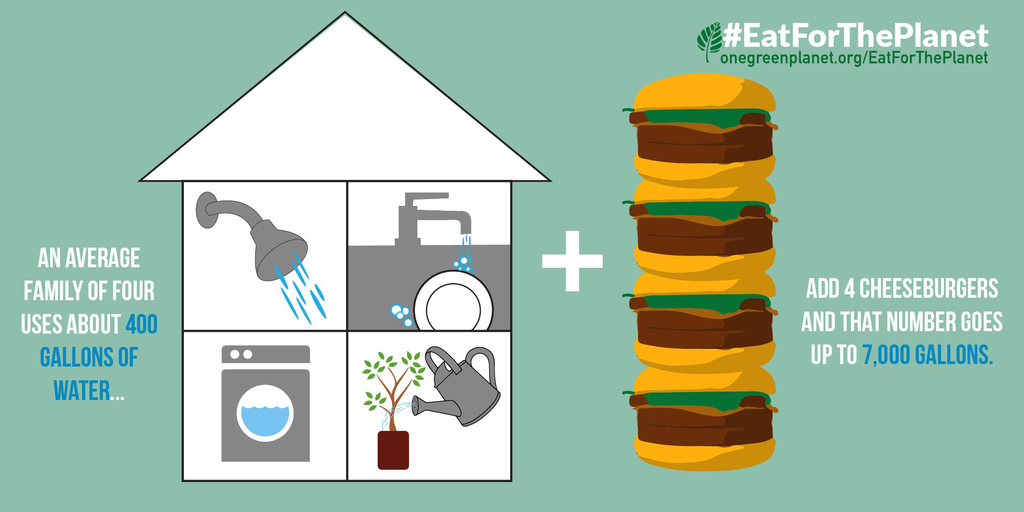How Does Eating Beef as a Primary Source of Food Affect Our Atmosphere
You lot care about the earth'southward precious water resources. You lot turn off the faucet when you're brushing your teeth and definitely don't take twenty-infinitesimal long showers. While these acts–forth with the use of appliances that save water like toilets and showerheads–are fantastic means to conserve water, if yous really want to make a difference with water conservation, at that place's a bigger piece of the puzzle to consider.
Every food and beverage product we consume: from soda to pineapples to cheese crackers and pork chops, etc. requires h2o for its product. Plain, fruits and veggies need water. That'south a given, but surprisingly, there is another group of foods that is the biggest water guzzler of them all and that is animal products. Meat, dairy, and eggs crave more water to "produce" than any other food out there.
Then exactly how does eating these products increment your water footprint? Here'southward the scoop!
The Boilerplate Family
According to the United StatesEnvironmental Protection Agency, an average family of four uses about 400 gallons of water a day for various indoor activities, including: taking showers, washing dishes, doing laundry and flushing the toilet. This statistic, however, doesn't fifty-fifty brainstorm to have into consideration how our food consumption affects our water footprint. If each fellow member of this hypothetical family unit of four ate a cheeseburger for dinner, the household'south water consumption that day would shoot up to over 7,000 gallons depending on the size of the burgers, the amount of cheese, etc. Why is this?

H2o Consumption in Animal Agriculture
The very fact that animals raised for food are live means they are going to consume water–either direct or through their food. Think nigh how much you eat and then think about a cow's appetite. They eat a lot – and nosotros swallow a lot of animals!
Farmed animals eat 70 percent of the grains and cereals grown in the United States and those grains have to be watered to grow! In fact, it takes 100 calories of grain to produce iii calories worth of beef. And information technology requires 1,799 gallons of water to produce one pound of meat.
To put that into perspective, an average U.Due south. swimming pool contains 22,500 gallons of water. A pond pool's worth of water would produce 12 pounds of beefiness. Allow's say 1 i,000 pound steer yields 610 pounds of beef. That ways a swimming puddle'south worth of h2o is required to produce just two pct of that steer's beef. Or to produce all 610 pounds of beefiness, 49 swimming pools worth of water or over one one thousand thousand gallons.
Co-ordinate to the American Meat Institute itself, in 2012 America produced 26 billion pounds of beef. So information technology took roughly 65 trillion gallons of water to produce beef in 2012. And that is just beefiness.
How Brute Agronomics Affects Your Overall Water Footprint
So, what does all this mean in terms of an private'due south h2o footprint? Unsurprisingly, our food and beverages make upwardly about half of our personal h2o footprints. Fortunately, each one of united states can brand a huge impact by simply rethinking our diet.
Just imagine if everyone cut their meat consumption by one-third. If you eat one-tertiary less meat, then you utilise one-third less water. We could go even further and cut our meat consumption in half and the impact would exist that much greater. The truth is, whether you decide to eat less meat or you abstain from it all together, we all can make a big difference on our individual h2o footprint through the power of our food choices.
Every bit the leading organization at the forefront of the conscious consumerism movement, it is One Light-green Planet'south view that our nutrient choices accept the power to heal our broken nutrient system, give species a fighting chance for survival, and pave the way for a truly sustainable hereafter.
By choosing to eat more found-based foods, you lot can drastically cutting your carbon footprint, salvage precious water supplies and help ensure that vital ingather resources are fed to people, rather than livestock. With the wealth of available found-based options bachelor, information technology has never been easier to swallow with the planet in mind.
For more Animal, Earth, Life, Vegan Food, Health, and Recipe content published daily, subscribe to the Ane Green Planet Newsletter ! Lastly, being publicly-funded gives u.s.a. a greater chance to proceed providing you with high-quality content. Please consider supporting united states by donating!
Being publicly-funded gives united states a greater gamble to go along providing yous with high-quality content. Click hither to Support Us
Source: https://www.onegreenplanet.org/animalsandnature/how-does-eating-meat-impact-your-water-footprint/


0 Response to "How Does Eating Beef as a Primary Source of Food Affect Our Atmosphere"
Post a Comment